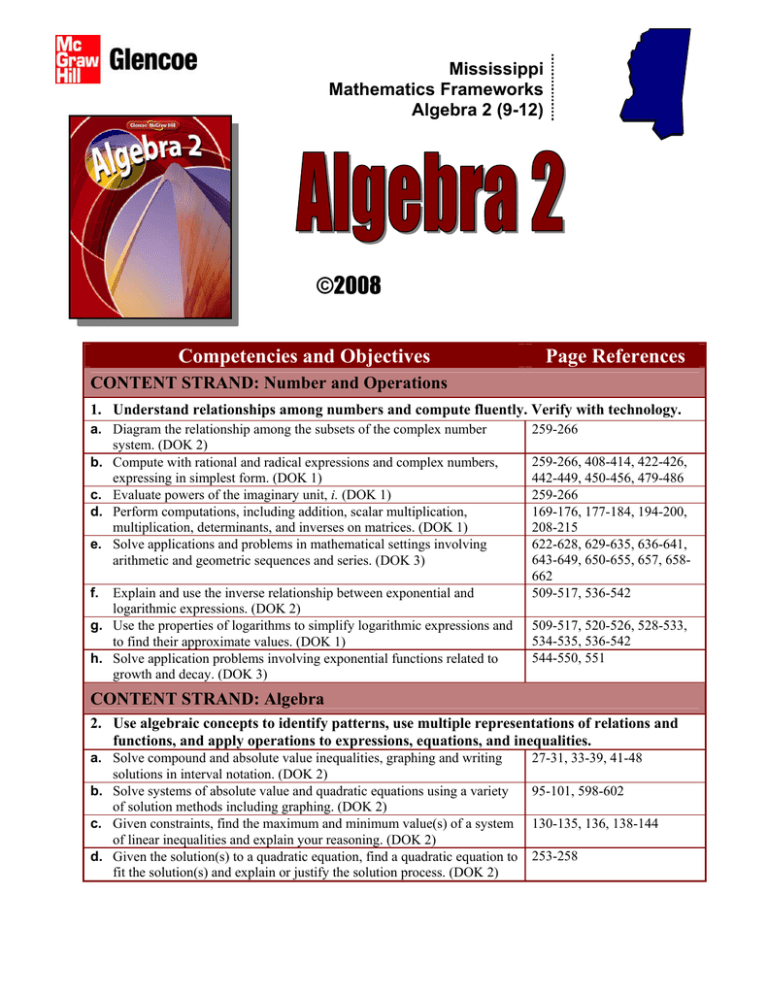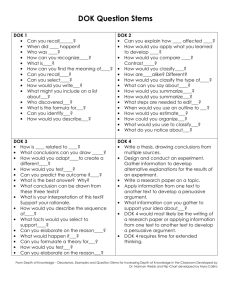Algebra 2 © 2008
advertisement

Mississippi Mathematics Frameworks Algebra 2 (9-12) ©2008 Competencies and Objectives Page References CONTENT STRAND: Number and Operations 1. Understand relationships among numbers and compute fluently. Verify with technology. a. Diagram the relationship among the subsets of the complex number system. (DOK 2) b. Compute with rational and radical expressions and complex numbers, expressing in simplest form. (DOK 1) c. Evaluate powers of the imaginary unit, i. (DOK 1) d. Perform computations, including addition, scalar multiplication, multiplication, determinants, and inverses on matrices. (DOK 1) e. Solve applications and problems in mathematical settings involving arithmetic and geometric sequences and series. (DOK 3) f. Explain and use the inverse relationship between exponential and logarithmic expressions. (DOK 2) g. Use the properties of logarithms to simplify logarithmic expressions and to find their approximate values. (DOK 1) h. Solve application problems involving exponential functions related to growth and decay. (DOK 3) 259-266 259-266, 408-414, 422-426, 442-449, 450-456, 479-486 259-266 169-176, 177-184, 194-200, 208-215 622-628, 629-635, 636-641, 643-649, 650-655, 657, 658662 509-517, 536-542 509-517, 520-526, 528-533, 534-535, 536-542 544-550, 551 CONTENT STRAND: Algebra 2. Use algebraic concepts to identify patterns, use multiple representations of relations and functions, and apply operations to expressions, equations, and inequalities. a. Solve compound and absolute value inequalities, graphing and writing solutions in interval notation. (DOK 2) b. Solve systems of absolute value and quadratic equations using a variety of solution methods including graphing. (DOK 2) c. Given constraints, find the maximum and minimum value(s) of a system of linear inequalities and explain your reasoning. (DOK 2) d. Given the solution(s) to a quadratic equation, find a quadratic equation to fit the solution(s) and explain or justify the solution process. (DOK 2) 27-31, 33-39, 41-48 95-101, 598-602 130-135, 136, 138-144 253-258 Competencies and Objectives e. Use the discriminant to classify and predict the types of solutions of quadratic equations and justify the classification. (DOK 2) f. Factor sums and differences of cubes and factor polynomials by grouping. (DOK 2) g. Solve radical equations. (DOK 2) h. Write equivalent forms of rational expressions using real and complex conjugates. (DOK 2) i. Solve equations involving rational expressions and verify solutions. (DOK 2) j. Explain the results of compositions of functions. (DOK 2) k. Explain the Binomial Theorem and use it to expand binomial expressions raised to positive integral powers. (DOK 2) l. Interpret the zeros and maximum or minimum value(s) of quadratic functions. (DOK 2) Page References 276-283 349-355 422-427, 428-429 259-266, 408-414, 442-459, 450-456 479-486, 487-488 384-390 664-669 339-345 CONTENT STRAND: Geometry 3. Use coordinate geometry to specify locations, describe relationships, and apply transformations to analyze algebraic relationships. a. Determine and justify whether the inverse of a relation or a function exists. (DOK 2) b. Classify functions based on sketches of their graphs. (DOK 2) c. Sketch and describe transformations of quadratic and absolute value functions. (DOK 2) d. Represent complex numbers and the sum of complex numbers in a complex coordinate plane. (DOK 1) e. Identify and sketch the essential graphs of the four conic sections: circle, parabola, ellipse, and hyperbola. (DOK 1) 391-396 473-478 95-101, 284-285, 286-292, 293 259-266 567-573, 574-579, 580, 581588, 590-597 CONTENT STRAND: Measurement 4. Understand measurable attributes of objects and apply appropriate techniques and formulas to determine measurements. a. Verify the appropriateness of the numerical value and the units of a variable in an equation. (DOK 2) b. Describe the level of accuracy of measurements in real-world situations by using absolute value inequalities. (DOK 1) Throughout the text, including 18-26, 58-64, 66-70 41-48 CONTENT STRAND: DATA ANALYSIS & PROBABILITY 5. Use technology to represent, analyze, and make inferences based on data. a. Through the use of technology, use scatter plots and linear and quadratic regression analysis to determine an appropriate function to model reallife data. (DOK 3) b. Solve simple combinations. (DOK 2) c. Model a data set using the median-fit-method with a linear equation and make predictions based on the model and the equation. (DOK 3) d. Identify the difference between permutations and combinations and use them to solve real-world problems. (DOK 2) Mississippi Mathematics Frameworks Algebra 2 2 86-91, 92-94, 252 690-695 86-91, 92-94 690-695, 697-702 Glencoe Algebra 2 © 2008






